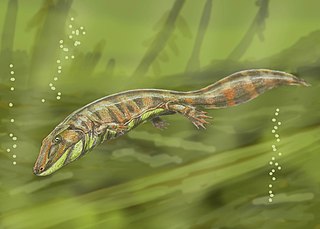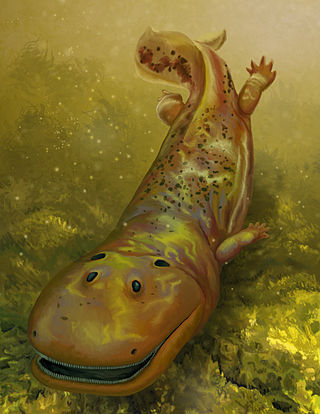
Baphetidae is an extinct family of stem-tetrapods. Baphetids were large labyrinthodont predators of the Late Carboniferous period of Europe. Fragmentary remains from the Early Carboniferous of Canada have been tentatively assigned to the group. The phylogenetic relationships of baphetids is uncertain; while many studies have placed the group as a close relative of Amniota, other analyses have found Baphetidae to be a more basal clade of early stem tetrapods. Baphetids were among the first of the Carboniferous fossil tetrapods to be found and were originally described in 1850 by John William Dawson. The baphetids have been referred to the family Loxommatidae, but this group was later shown to be a junior synonym of Baphetidae, which was named earlier in 1865. Baphetids are known mainly from skulls; very little postcranial material has been found.

"Labyrinthodontia" is an informal grouping of extinct predatory amphibians which were major components of ecosystems in the late Paleozoic and early Mesozoic eras. Traditionally considered a subclass of the class Amphibia, modern classification systems recognize that labyrinthodonts are not a formal natural group (clade) exclusive of other tetrapods. Instead, they consistute an evolutionary grade, ancestral to living tetrapods such as lissamphibians and amniotes. "Labyrinthodont"-grade vertebrates evolved from lobe-finned fishes in the Devonian, though a formal boundary between fish and amphibian is difficult to define at this point in time.

Reptiliomorpha is a clade containing the amniotes and those tetrapods that share a more recent common ancestor with amniotes than with living amphibians (lissamphibians). It was defined by Michel Laurin (2001) and Vallin and Laurin (2004) as the largest clade that includes Homo sapiens, but not Ascaphus truei. Laurin and Reisz (2020) defined Pan-Amniota as the largest total clade containing Homo sapiens, but not Pipa pipa, Caecilia tentaculata, and Siren lacertina.

Anthracosauria is an order of extinct reptile-like amphibians that flourished during the Carboniferous and early Permian periods, although precisely which species are included depends on one's definition of the taxon. "Anthracosauria" is sometimes used to refer to all tetrapods more closely related to amniotes such as reptiles, mammals, and birds, than to lissamphibians such as frogs and salamanders. An equivalent term to this definition would be Reptiliomorpha. Anthracosauria has also been used to refer to a smaller group of large, crocodilian-like aquatic tetrapods also known as embolomeres.

Crassigyrinus is an extinct genus of carnivorous stem tetrapod from the Early Carboniferous Limestone Coal Group of Scotland and possibly Greer, West Virginia.

Eucritta is an extinct genus of stem-tetrapod from the Viséan epoch in the Carboniferous period of Scotland. The name of the type and only species, E. melanolimnetes is a homage to the 1954 horror film Creature from the Black Lagoon.

Dendrerpeton is a genus of an extinct group of temnospondyl amphibians. Its fossils have been found primarily in the Joggins Formation of Eastern Canada and in Ireland. It lived during the Carboniferous and is said to be around 309–316 million years of age, corresponding to more specifically the Westphalian (stage) age. Of terrestrial temnospondyl amphibians evolution, it represents the first stage. Although multiple species have been proposed, the species unanimously recognized is D. acadianum. This species name comes from “Acadia” which is a historical name for the Nova Scotia region as a French colony. It refers to the location of the coal field at which the fossil was found.

Embolomeri is an order of tetrapods or stem-tetrapods, possibly members of Reptiliomorpha. Embolomeres first evolved in the Early Carboniferous (Mississippian) Period and were the largest and most successful predatory tetrapods of the Late Carboniferous (Pennsylvanian) Period. They were specialized semiaquatic predators with long bodies for eel-like undulatory swimming. Embolomeres are characterized by their vertebral centra, which are formed by two cylindrical segments, the pleurocentrum at the rear and intercentrum at the front. These segments are equal in size. Most other tetrapods have pleurocentra and intercentra which are drastically different in size and shape.

Pholiderpeton is an extinct genus of embolomere amphibian which lived in the Late Carboniferous period (Bashkirian) of England. The genus was first named by Thomas Henry Huxley in 1869 to include the species P. scutigerum, based on the disarticulated front half of a skeleton discovered near Bradford, Yorkshire. Associated fossil wood suggests that this specimen died inside a Lepidodendron tree trunk.

Diplovertebron is an extinct genus of embolomere that lived in the Late Carboniferous period (Moscovian), about 310 million years ago. Diplovertebron was a medium-sized animal, around 50 cm in length. Members of the genus inhabited European Carboniferous swamps in what is now the Czech Republic. They were closely related to larger swamp-dwelling tetrapods like Proterogyrinus and Anthracosaurus. However, Diplovertebron were much smaller than these large, crocodile-like creatures. Known from a single species, Diplovertebron punctatum, this genus has had a complicated history closely tied to Gephyrostegus, another genus of small, reptile-like amphibians.

Anthracosaurus is an extinct genus of embolomere, a possible distant relative of reptiles that lived during the Late Carboniferous in what is now Scotland, England, and Ohio. It was a large, aquatic eel-like predator. It has a robust skull about 40 centimetres (1.3 ft) in length with large teeth in the jaws and on the roof of the mouth. Anthracosaurus probably inhabited swamps, rivers and lakes. Its name is Greek for "coal lizard".

Spathicephalus is an extinct genus of stem tetrapods that lived during the middle of the Carboniferous Period. The genus includes two species: the type species S. mirus from Scotland, which is known from two mostly complete skulls and other cranial material, and the species S. pereger from Nova Scotia, which is known from a single fragment of the skull table. Based on the S. mirus material, the appearance of Spathicephalus is unlike that of any other early tetrapod, with a flattened, square-shaped skull and jaws lined with hundreds of very small chisel-like teeth. However, Spathicephalus shares several anatomical features with a family of stem tetrapods called Baphetidae, leading most paleontologists who have studied the genus to place it within a larger group called Baphetoidea, often as part of its own monotypic family Spathicephalidae. Spathicephalus is thought to have fed on aquatic invertebrates through a combination of suction feeding and filter feeding.

Megalocephalus is an extinct genus of baphetid amphibian from the late Carboniferous of the British Isles and the United States (Ohio). It contains two species, M. pachycephalus and M. lineolatus.

Loxomma is an extinct genus of Loxommatinae and one of the first Carboniferous tetrapods. They were first described in 1862 and further described in 1870 when two more craniums were found. It is mostly associated with the area of the United Kingdom. They share features with modern reptiles as well as with fish. They had 4 paddle-like limbs that they used to swim in lakes, but they breathed air. Their diet consisted mostly of live fish. They are of the family Baphetidae which are distinguished by their keyhole shaped orbits, while Loxomma themselves are distinguished by the unique texture on their skulls, said to be honeycomb-like.

Neopteroplax is an extinct genus of eogyrinid embolomere closely related to European genera such as Eogyrinus and Pteroplax. Members of this genus were among the largest embolomeres in North America. Neopteroplax is primarily known from a large skull found in Ohio, although fragmentary embolomere fossils from Texas and New Mexico have also been tentatively referred to the genus. Despite its similarities to specific European embolomeres, it can be distinguished from them due to a small number of skull and jaw features, most notably a lower surangular at the upper rear portion of the lower jaw.

Acherontiscus is an extinct genus of stegocephalians that lived in the Early Carboniferous of Scotland. The type and only species is Acherontiscus caledoniae, named by paleontologist Robert Carroll in 1969. Members of this genus have an unusual combination of features which makes their placement within amphibian-grade tetrapods uncertain. They possess multi-bone vertebrae similar to those of embolomeres, but also a skull similar to lepospondyls. The only known specimen of Acherontiscus possessed an elongated body similar to that of a snake or eel. No limbs were preserved, and evidence for their presence in close relatives of Acherontiscus is dubious at best. Phylogenetic analyses created by Marcello Ruta and other paleontologists in the 2000s indicate that Acherontiscus is part of Adelospondyli, closely related to other snake-like animals such as Adelogyrinus and Dolichopareias. Adelospondyls are traditionally placed within the group Lepospondyli due to their fused vertebrae. Some analyses published since 2007 have argued that adelospondyls such as Acherontiscus may not actually be lepospondyls, instead being close relatives or members of the family Colosteidae. This would indicate that they evolved prior to the split between the tetrapod lineage that leads to reptiles (Reptiliomorpha) and the one that leads to modern amphibians (Batrachomorpha). Members of this genus were probably aquatic animals that were able to swim using snake-like movements.

Odonterpeton is an extinct genus of "microsaur" from the Late Carboniferous of Ohio, containing the lone species Odonterpeton triangulare. It is known from a single partial skeleton preserving the skull, forelimbs, and the front part of the torso. The specimen was found in the abandoned Diamond Coal Mine of Linton, Ohio, a fossiliferous coal deposit dated to the late Moscovian stage, about 310 million years ago.

Eldeceeon is an extinct genus of reptiliomorph from the Mississippian of Scotland. It is known from two fossil specimens found within the Viséan-age East Kirkton Quarry in West Lothian. The type and only species, E. rolfei, was named in 1994. Eldeceeon is thought to be closely related to embolomeres, but it has several distinguishing features including long limbs and a short trunk. Initially known from two crushed partial skeletons, additional specimens have been reported by Ruta & Clack (2006). Eldeceeon was redescribed by Ruta, Clack, & Smithson (2020). The redescription supported affinities with Silvanerpeton, reconstructed a skull with larger eyes and a shorter snout, and emphasized potential correlations for an enlarge puboischiofemoralis internus 2 muscle.
Eobaphetes is an extinct genus of embolomere which likely lived in the Pennsylvanian of Kansas. The genus is based on several skull and jaw fragments of a single individual. They were originally described under the species Erpetosuchus kansasensis, but this was later changed to Eobaphetes kansasensis when it was determined that Erpetosuchus was preoccupied by a Triassic reptile.
Palaeoherpeton is an extinct genus of eogyrinid embolomere which lived in the Pennsylvanian of Scotland. It is primarily known from a series of relatively small but well-preserved skulls. Some of these have among the best braincase and middle ear material known in embolomeres. Originally given the species name Palaeogyrinus decorus, this was later corrected to Palaeoherpeton decorum when it was determined that Palaeogyrinus was a name preoccupied by a genus of beetles.
























